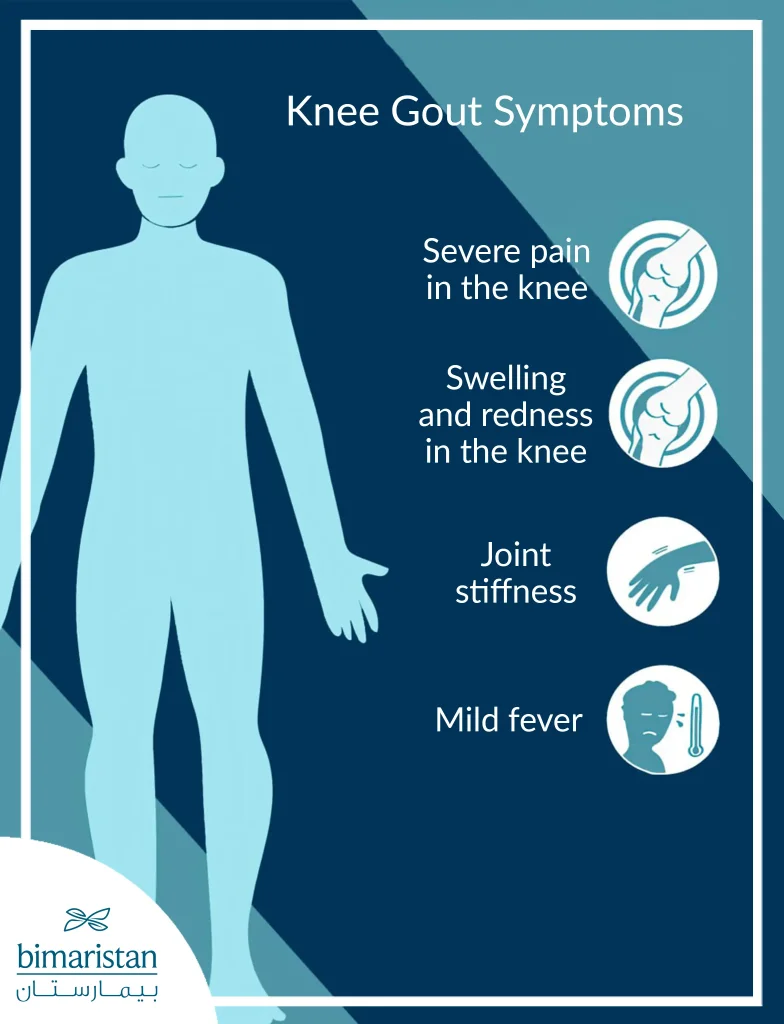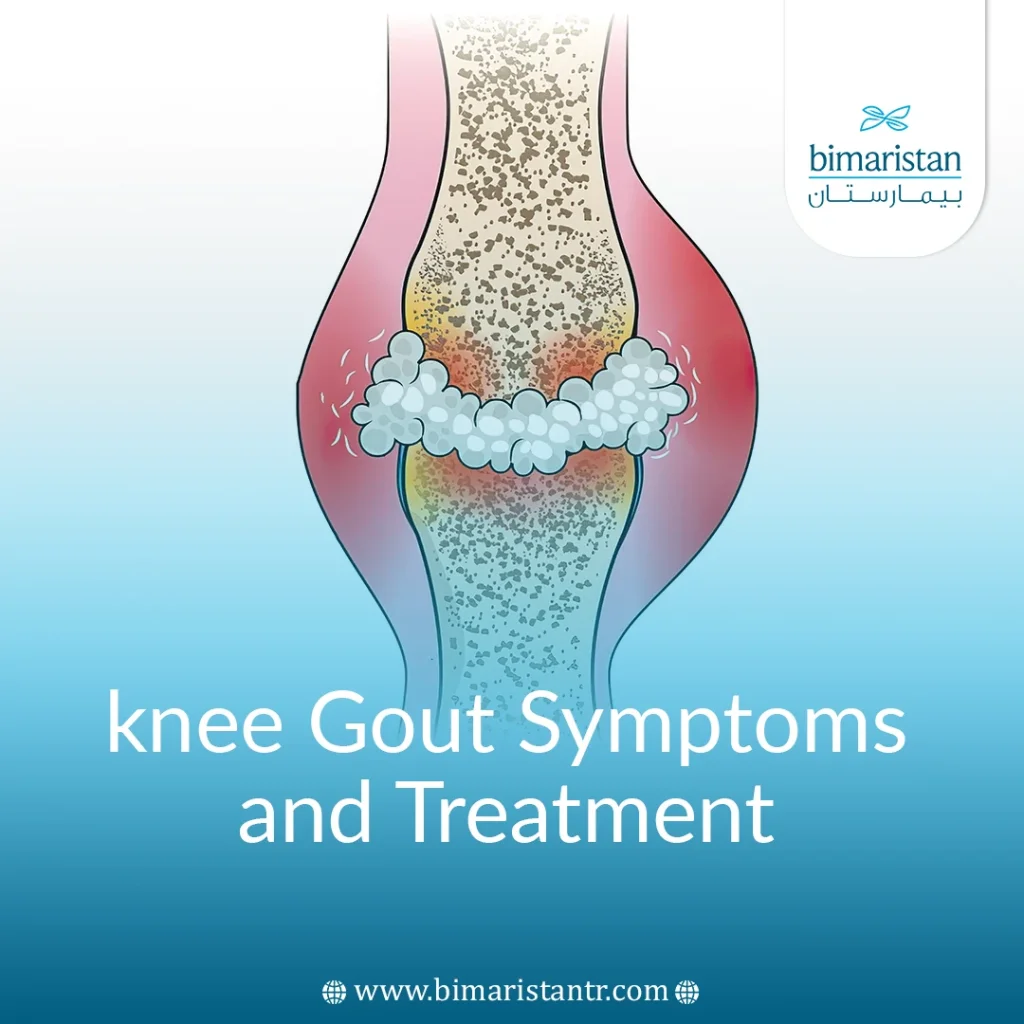Gout in knee is severely painful. This condition can affect all joints in your body without exception. So, what are knee gout symptoms?
Although gout is more common in the big toe, knee involvement is not rare. Knee gout symptoms may be somewhat misleading due to the presence of many diseases that affect the knee and cause similar symptoms to gout.
Let’s understand the main signs and symptoms of gout in the knee together and how to treat it properly.
What are the symptoms of gout in the knee?
Gout, also known as the “disease of kings,” is an inflammatory condition that causes sudden attacks of severe joint pain. These attacks are most commonly seen in the foot but can also affect the knee and other joints in the body.
Arthritis gout in knee usually does not cause symptoms immediately; it may take weeks or even months for them to manifest.
Gout tends to reveal itself suddenly. The patient often wakes up from sleep feeling severe pain and discomfort despite being active and in good health the day before.
The most prominent knee gout symptoms include:
- Severe pain aggravated by pressure or touching the knee
- Swelling, redness, and warmth in the knee
- Stiffness with difficulty moving the joint
- Itching with peeling of the skin
As mentioned earlier, knee gout symptoms come in the form of attacks. A person may only experience knee gout symptoms once or twice a year, while the symptoms may be more frequent in untreated severe cases of gout.
An attack usually lasts about 5 to 7 days before the symptoms subside. The more severe the gout, the longer the attacks may last, with severe attacks sometimes taking months to resolve.

What causes gout in the knee?
Gout is a form of arthritis that affects multiple locations in the body, especially the big toe or ankle. It can also affect one or both knees.
Gout is caused by an excess of uric acid in the blood due to increased production or decreased excretion. This leads to the formation of sharp uric acid crystals that accumulate in the knee joint (gout fluid in knee), causing knee pain due to uric acid.
The body produces uric acid by breaking down purines naturally found in the body or some foods. When this mechanism is imbalanced, excess acid occurs.
Red meat, seafood like sardines, alcoholic beverages, some vegetables like cauliflower and spinach, and mushrooms are among the foods rich in purines and are the leading causes of gout in knee.
Gout in knee treatment
The main goal of treating gout in the knee is to relieve symptoms of the attack and reduce the frequency of attacks (gout in knee relief). There is no definitive cure for this condition.
Lifestyle changes are an essential step in treatment.
Combining some medications with healthy dietary modifications significantly helps control knee gout symptoms.
Treatment of knee gout with medications
The benefits of medications lie in relieving knee gout symptoms during attacks by alleviating pain and reducing joint inflammation. They also help prevent the recurrence of attacks. There are several drug classes used in managing gout, including:
Nonsteroidal anti-inflammatory drugs (NSAIDs)
These include various types of over-the-counter pain relievers and anti-inflammatories like ibuprofen. However, it is essential to note that patients with kidney failure and peptic ulcers are prohibited from taking this class due to some side effects.
Colchicine compounds
This medication helps relieve knee gout symptoms and reduce joint inflammation when given within 24 hours of the onset of the attack. However, it may be associated with some side effects, such as nausea, diarrhea, or vomiting.
Uric acid-lowering agents
These drugs aim to reduce uric acid levels in the body, which helps prevent knee gout symptoms and alleviate their severity. Examples under this category include Allopurinol and Febuxostat.
Knee injections
Injections of certain pharmacological compounds, such as corticosteroids, into the joint help treat and alleviate knee gout symptoms. However, treatment may have side effects like mood changes or increased blood pressure.
A new technique, knee plasma injections, has recently emerged for treating knee diseases and osteoarthritis. Studies are still ongoing about its effectiveness in treating gout.
Dietary management for treating gout in the knee
A low-purine healthy diet is one of the most effective ways to treat knee gout. As mentioned earlier, the human body produces uric acid by breaking down purines.
Avoiding alcohol and sugar-sweetened beverages, as well as not overeating red meat, helps reduce gout attacks in the knee. Regular exercise while maintaining a proper weight also contributes to prevention and treatment.

Complications of Gout in Knee
If gout treatment is neglected, complications may develop, and some pose a risk to the patient’s life. Therefore, the patient must adhere to the treatment plan specified by the doctor.
Among the effects and complications that gout may cause are the following:
- Formation of masses under the skin of the knee called tophi, which are accumulations of uric acid crystals.
- Joint deformity may occur due to inflammation, chronic swelling, and tophi formation.
- Kidney stones may accumulate due to the transfer of gout crystals and their accumulation in the urinary tract.
- Uric acid stones may lead to kidney failure and may progress to kidney failure.
- Some individuals may experience psychological symptoms such as depression.
Severe gout symptoms over time may lead to damage to the knee joint, necessitating joint replacement surgery.
Risk factors for gout in the knee
Some factors may contribute to an increased risk of developing gout and increase the frequency and severity of knee gout symptoms, including:
- Obesity and overweight
- Some chronic diseases, such as diabetes or kidney failure
- A diet rich in purines
- Having a first-degree relative with gout
- Men are more prone to gout than women
- Gout mainly affects the age group from 30 to 50 years old
- Undergoing surgery or being involved in a traumatic accident may trigger a gout attack
- Some medications, such as aspirin and blood pressure medications

Diagnosing knee gout
Doctors often diagnose gout based on symptoms of the condition and the appearance of the affected joint upon physical examination. Some tests may be ordered to confirm the diagnosis, including:
Synovial fluid aspiration
This is done by drawing a fluid sample from inside one of the joints affected by gout using a needle. The fluid is then examined under a microscope for uric acid crystals.
Blood uric acid measurement
A blood sample is taken to measure the uric acid level. A high level indicates the possibility of gout, but it is not definitive. Some people may have high levels without having gout, while others may have signs and symptoms of gout in the knee despite normal acid levels in the body.
X-ray imaging
X-rays rule out other causes in the knee area that mimic knee gout symptoms, such as osteoarthritis and fractures. Ultrasound or magnetic resonance imaging (MRI) may be used in this context to rule out knee tendon inflammation.
In conclusion, knee gout symptoms often appear in annual attacks, on average, once or twice a year. Consult your doctor if you notice any knee gout symptoms, as early treatment can better control symptoms and avoid attacks.
References:



